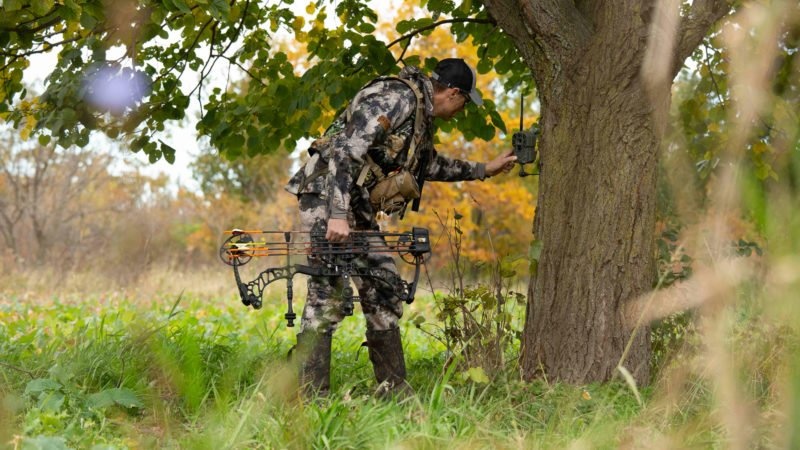The bad side of trail cams
- Posted on
- By Daniel Larocque
- 0

Tips and tricks to better manage your trail cameras.
Back in a not-so-distant time.
20 years ago, in my first year of business, I believe I ordered a total of 10 trail cameras annually to sell in store.
These firsts cameras were called TrailMac which I imported from the United States at the wonderful exchange rate of 1.49% and came in at a selling price of plus or minus $ 500.00 Canadian.
I believe I have sold 2 or 3 of them to certain customers who understood the practicality and the advantages that this would bring to their hunts. For the rest of the cameras that didn't sell and collected dust in the store, I became my best customer. At that time I was intensely guiding for bear hunting and it was with TrailMac that I started to spend my pension fund! ;)

The first cameras were simply designed with a box containing a Canon Owl 35mm cameras with flash that offered limited adjustments for setting the delay between shots. Since they were flash camera, the quality of the photos was extraordinary and even at night with color.
The problem with that type of cameras was their image storage capacities which were limited between 24 to 36 exposures. One night and the film roll was full. This required me to go and replace my film rolls every 24-48 hours during my bait barrel refills. Then, I would rush to have the photos developed at an hour developing photo store because I was very anxious to see the animals that had shown up in front.
 |
 |
 |
From the very first photo development session and seeing the images of the trophy specimens that came to taste my donuts, I quickly understood how to use this technology to my advantage. This allowed me to know the inventory of game that was on my territory and their hours of movement.
Fortunately, the price of gasoline was at 69 cents per liter because a new type of addiction was born.
Photo recovery.
Since then, the surveillance camera industry has exploded by offering us the possibility of capturing quantities of data thanks to high-capacity SD cards. We can now capture images either in photo and video mode day and night with infrared technology which replaced the flash. Even today I wonder if the flash would not be to our advantage because for game it is like lightning which is totally natural. Especially on the trails.
In recent years, cellular cameras have taken more and more place in hunting shops because several hunters have cellular coverage at their hunting location. They can use this technology and receive their data directly on their smartphones or tablets. The advantage of this type of camera is that it allows hunters to avoid visits and infect their hunting grounds with their own smells.

My goal is not to update you on the history of cameras but rather to make you understand something. Since the arrival of this technology, many hunters have reduced their chances of harvesting because they do not take the necessary precautions when they go retrieve their photos.
Today, there are tens of thousands of cameras in the forest, which means that we can now count thousands of human intrusions in the forest before opening date and during the hunt. These intrusions are now much more frequent than before the arrival of those cameras! For the past ten years or so, archers have noticed that the deer were much more nocturnal in the pre-season than before.
So what does this mean?
In the past, we use to head-out to our hunting camp the day before the opening with our group of friends and family members. In the evening, there were no such discussions ... I want the big 10 crooked pallet points, or the high rack 8 points, or the 6 1/2 years old, etc.
Before cameras, hunters had no game to target except game missed from previous years or observed in fields, on paths or bodies of water during a fishing trip. The hunters simply dreamed of harvesting the large specimen that left a large trail or impressive rubbing and scrapes.
On the morning of the opening, each of the hunters headed to their respective hideout posts. The game suddenly experienced a surprise intrusion that left him no chance to prepare for this invasion. He adjusted as best he could, as quickly as possible because he was being pushed from right to left by the hunters. That was the good old days!
With the arrival of trail cams and the popularity of baiting, the strategies have changed and especially in favor of games. The reason is simple. As mentioned above, we already surprised games. Today it is rather the opposite that is taking place and here’s why.
You will all agree that most hunting installations are very similar. A hideout or watchtower facing a bait or mineral licks that are constantly peppered with photos by one and even sometimes more than a camera.
The new generation of deer, moose and bears recognize the smell of plastic in a camera as well as the noise and light that some of them produce.
Here is a clip of a moose picking up the scent of my camera and it had been in the forest for over 12 months.
The smell of camera combined with apples and carrots also come with the human smell. Every time you set foot in your territory you are leaving your scent trail.
The younger animals are less alerted, but the mature ones now understand. Nothing prevents that young animal to get more informed and educated at a mature age if he gets to that age.
Today, I take extra care every time I set up a camera and take the time to spray it with an odor eliminator wiped off by an odorless rag. Especially on their first annual outing, even if they are stored in a separate room dedicated only to my hunting equipment. This can prevent the game from smelling the camera and potentially moving it. There is nothing more frustrating to arrive weeks later and have the camera no longer point where you planned.
Take your precautions when going to retrieve your data. Act as if you are in hunt mode. You are less likely to alert them during your intrusions. Wear rubber boots, enter with the wind in your favor and avoid going there during the hours most conducive to game activity. If possible, go on a rainy day to rinse your trail as much as possible.
This year I was guiding a moose hunter. He would have liked to tour my 13 cameras the day before the opening of the season. He was a little disappointed when I told him that we were going to get to them only in hunting mode. That is the only way we were going to recover the SD cards. When I mention in hunting mode, it means entering with the wind in our favor and dressed in odorless clothing, etc.
With the durability of the batteries and the capacity of the SD cards today, it allows you to avoid going to your hunting sites. Limit your visits and remember that in short ... the wind is your best friend or your worst enemy.
It's up to you to take advantage of it.


Comments
Be the first to comment...